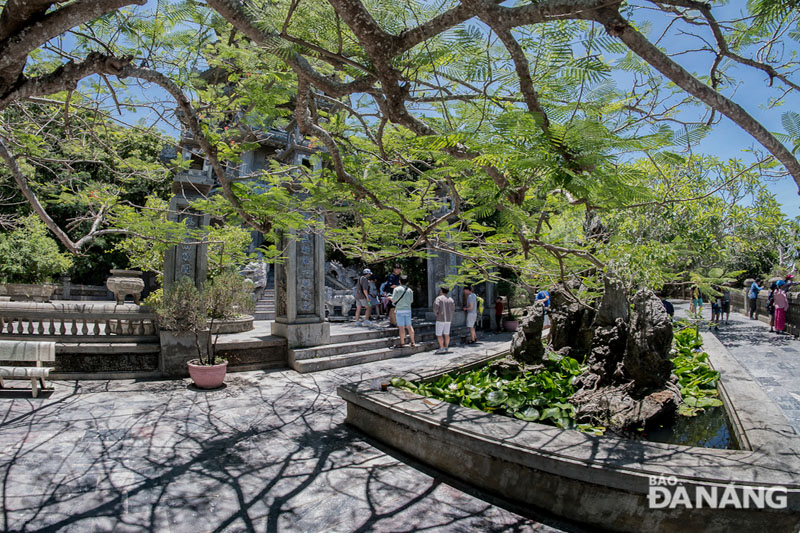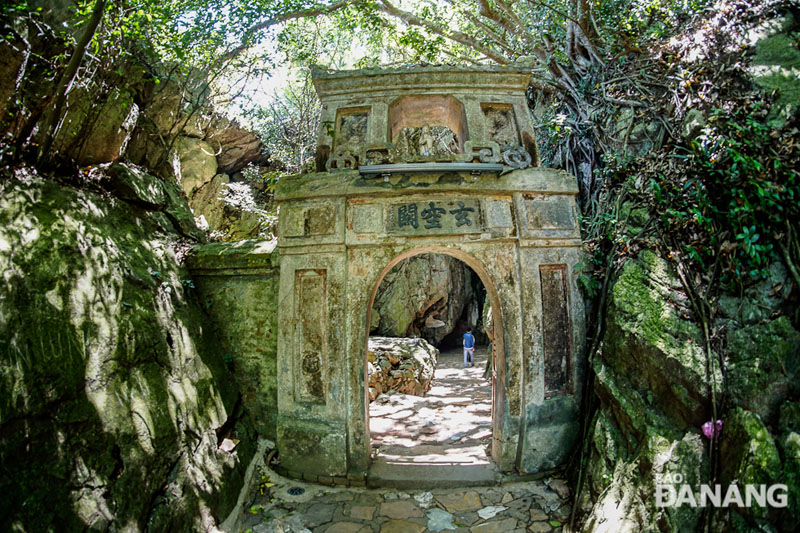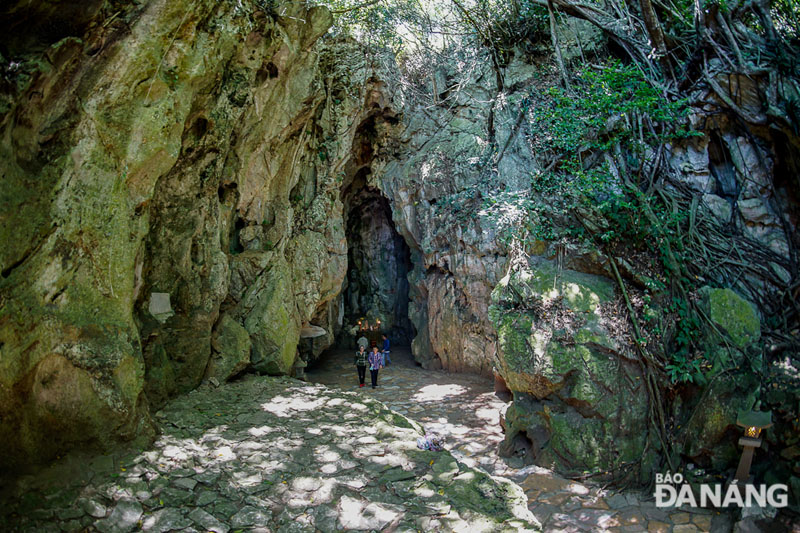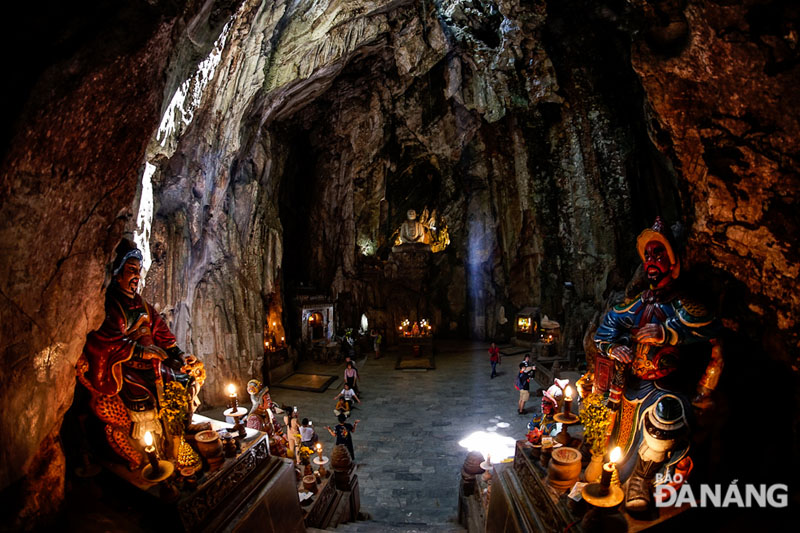Everything You Need to Know about Marble Mountain – You in Da Nang
You’ll have to climb more than a few steps to get up to Marble Mountains. These steps are cut from solid stone and each one takes you up the steep karts and higher over the horizon. Before you know it, you’ve reached the top. Welcome to Marble Mountains. This riveting attraction outside Da Nang is part historical treasure, part natural wonder, part spiritual setting, and totally beautiful. Read on for an insider guide to Da Nang’s marvelous Marble Mountains.
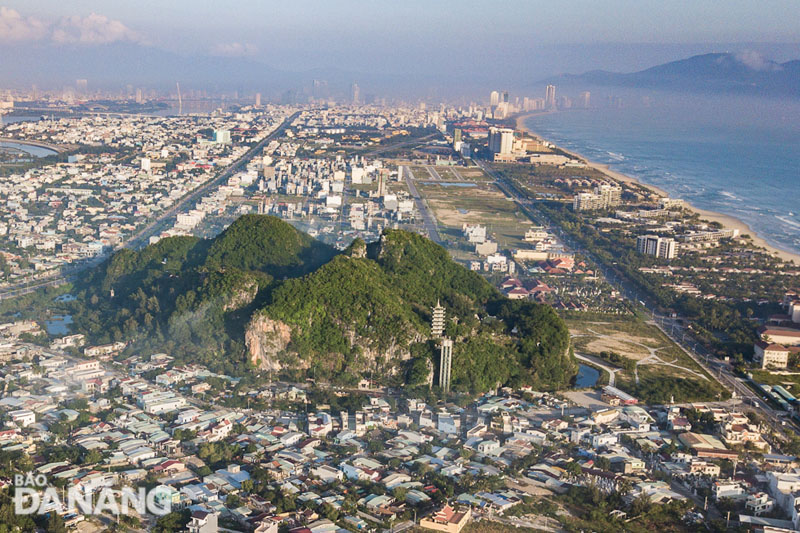
Why Marble Mountain is special
The Marble Mountains were not named by the Vietnamese, but by the French after studying the chemical element of the mountain’s soil. In Vietnamese, it is known as Ngu Hanh Son (The Five Element Mountain). Accordingly, there are five separate mountains in the cluster, named after the five basic elements of life (according to Eastern philosophy): Kim Son (Mt. Metal), Moc Son (Mt. Plant), Thuy Son (Mt. Water), Hoa Son (Mt. Fire), and Tho Son (Mt. Soil).
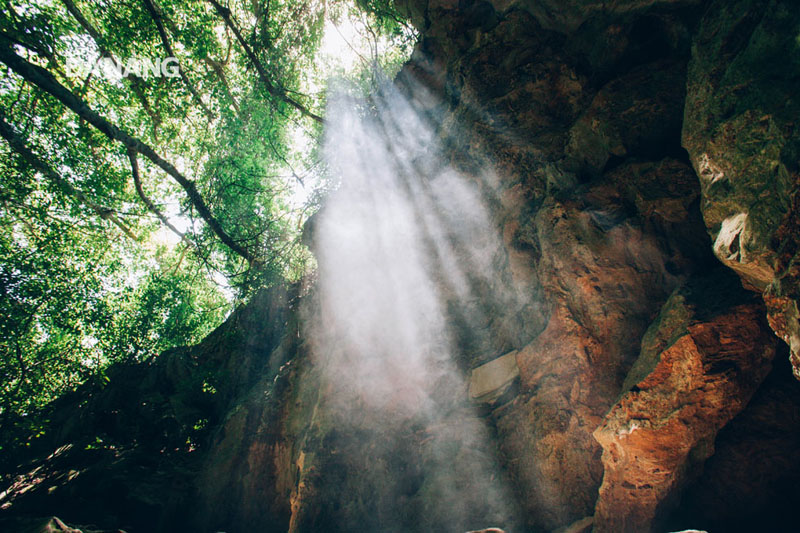
Named by King Minh Mang, the five mountains were once a favorite destination for either the noble classes to visit or the anchorites, a Japanese school of Mahayana Buddhism emphasizing the value of meditation and institution, to set up sanctuaries. However, the history of this mountain cluster can be traced to hundreds of years before that, when the whole region still belonged to the Cham Kingdom. Today, stepping on each rustic stone stair, listening to your heart beat among the swinging rhythm of the forest, you could still feel the hundred-year-old statues whispering stories of the old days.
What to explore at Marble Mountain
According to oriental philosophy, Metal, Plant, Water, Fire and Soil are five elements that create the universe. Five is a very important number in oriental mentality and life. And so, the five mountains that compose Marble Mountain are filled with mysterious.
1. Soil
Before being conquered by the Tran Dynasty in 1471, this mountain was a good shelter for the Cham. Today, in one part of Mt. Soil, you can still find traces of the Cham Temples, the structure resembling that of My Son (a significant architectural structure of Hinduism, as Hindu had been the national religion of the Cham then), however less preserved. There are not many relics of historical construction on this side of the Marble Mountains. But hang on, the most attractive part is on your way – Mt. Water.
2. Water
Since being a part of Vietnam, the Marble Mountains, especially Mt. Water, has become a sacred place that attracts many Buddhist anchorites. If your time is limited, just pay the other mountains a short look on the internet, but never forget to drop by Mt. Water. Mother Nature and human beings over the past few centuries have been making this place an art of sanctuaries.
Pagodas and shrines
One of the best parts of Marble Mountain is seeing the striking pagodas that claim this elevated perch. Linh Ung Pagoda announces itself with an amazingly detailed archway facing the sweep of Non Nuoc Beach. Stop here for photos before wandering around the courtyard to admire the small lotus ponds, bonsai plants and tile work of the main structure. Nguyen Emperor Gia Long first ordered the pagoda built in 1825, and it bears many of the same motifs found in the UNESCO-listed tombs in Hue. A short walk away you’ll reach Xa Loi Tower. This 28-metre structure houses 200 statues of Buddha, and offers breathtaking views of the landscape below.
Mt. Water is famous for its amazing system of pagodas and shrines either on the ground or inside the caves. Among many sacred pagodas there, Tam Thai Pagoda is a lively witness of the past that you surely do not want to miss. Head to the West of Mt. Water, walk 156 stone steps (built in 1630) set into the spine of the mountain, you will find yourself standing in front of an ancient three-entrance gate leading to a sunny yard.
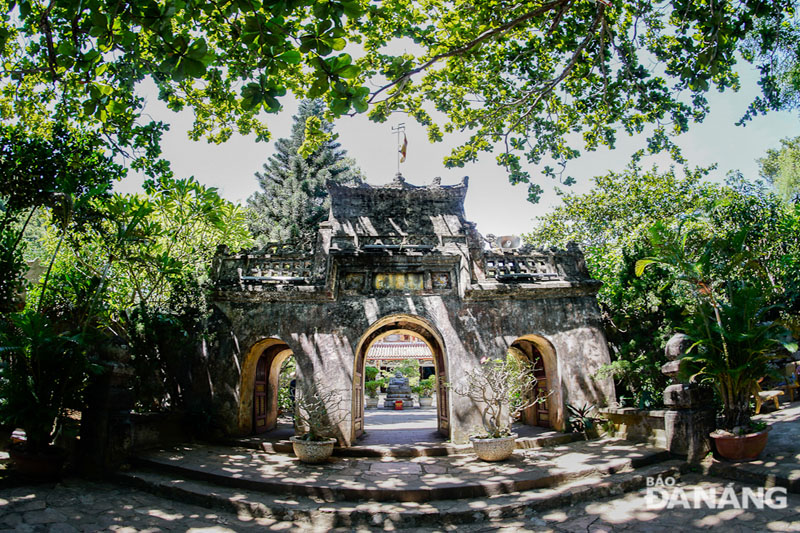
It’s there that the 400-year-old pagoda makes its home. It was built in the 17th century, renovated many times, heavily destroyed during the doughty Tay Son Rebellion, significantly rebuilt in 1825 by King Minh Mang – the son of Tay Son’s enemy, destroyed again during the Vietnam War and the storm in 1991, then reconstructed… Today, you can still see the big copper plate molded under the King’s demand, inscribed with his gratitude toward Sakya Muni Buddha.
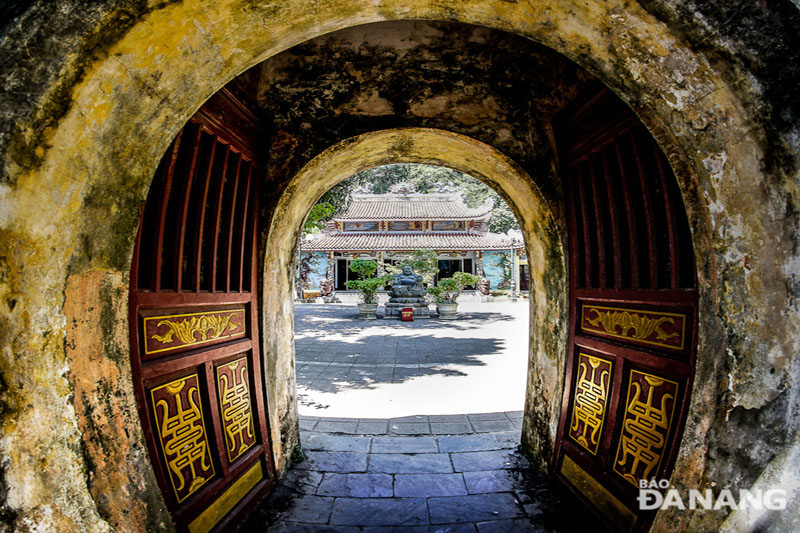
It seems as though this old pagoda wants to rest itself after those turbulent times, welcoming tourists from thousands of places around the world to its gentle sunny yard and humming a calming sound as if to echo peace to all its visitors.
Also read: 03 Linh Ung Pagoda Which You Can NOT Miss If You Come in Da Nang
It is not wrong to say that Mother Nature joins hands in making Mt. Water a Buddhist Sanctuary. If you look carefully at all the names of its caves cluster, you will notice that many of their names have Buddhist elements: Huyen Khong (Miracle Nothingness), Hoa Nghiem (Grave Rosin), Van Thong (Touching my Butt), etc. If you are on a tour, you will likely be taken to all of them.
Huyen Khong Cave – Heavenly light
Have you ever been enchanted with the way that light moves through natural landscapes, how light itself is meant to bend around things and reflect just to illuminate the beautiful? Such scenes of light and its ability to reveal beauty exist in Huyen Khong Cave, just as you descend the staircase into the mouth of the cavern. You will be amazed. Every fiber of sunlight slightly drops over the gravely gentle face of the huge Buddha statue sculpted naturally into the cliff opposite the gateway. The statue was made recently, in 1960.
If you walk further into the right part of the cavern (to the left of the Buddha statue), you will find the old Trang Nghiem Tu Temple, built in 1825, with three compartments. The main compartment is meant for worshipping Bodhisattva – who is believed to appear when you are in danger and you call for miracle help. The compartment on the left is for the worship of three Goddesses: Quan Cong, Quang Binh, and Chau Xuong, who respectively symbolize Morality, Wisdom, and Loyalty. The statue on the right is for worshipping the Goddess couple that bring good blessing to couples.
This sacred venue has undergone much change and been a witness to tumultuous history. More than once, the Marble Mountains have been used as an army station. During the French Colonial War, the cavern was a secret base for the local revolutionary authority. Afterward, since the Vietnam War, the American and the South Vietnam Government made this cavern a military exercise venue. In 1968, the Viet Minh took the control of the place, turning Huyen Khong cave into a surgery and medical spot of the liberation army. Place your hand on the stone of these caves, and you might understand why so many people have used it as a shelter of sorts.
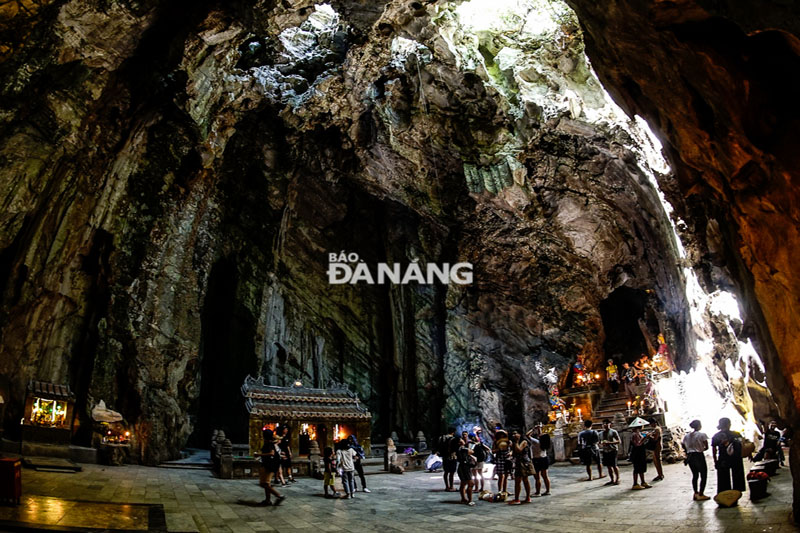
Am Phu (Hell) Cave – Wondering what hell looks like
Opposite the depicted heavens of Huyen Khong Cave, Am Phu Cave is a tour of you guessed it, hell. But this isn’t an ordinary hell (if such a thing exists). Dark, humid, and at points fear-inducing, this cave is truly a good embodiment of what we believe hell to look like. With strange creatures hidden in the pockets of darkness and winding stairs that lead to spooky scenes, there is constantly entertainment, and frightening faces in every corner.

Sir Good and Sir Bad guard the gate of hell. The Hell Cave is 302 meters long with great height, at some points the height reaches 40 to 50 meters. The natural cavern was cleverly crafted, sculptures were installed to deliver the core Buddhist belief: Karma – everything has its consequences. In this Am Phu (Hell) Cave, the painful torture of bad people represents Karma, the extent of pain depends on the extent of their sins in past lives.
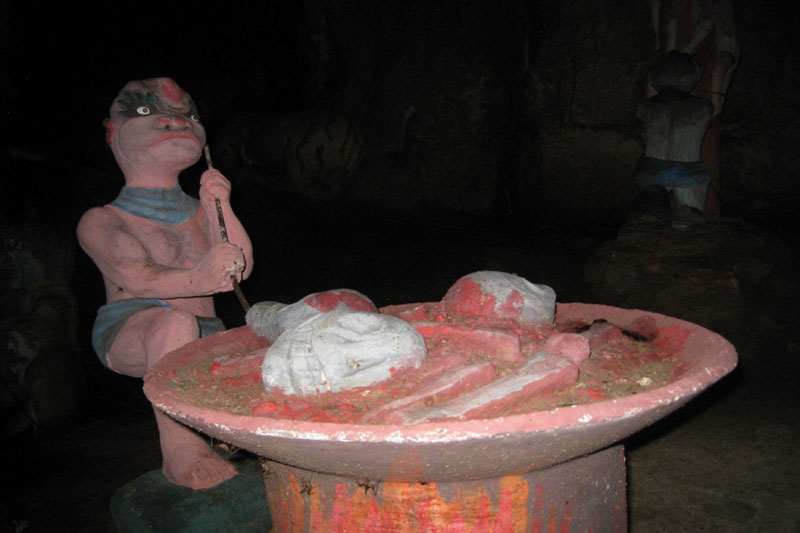
At the end of the cave, you will see the statue of Saint Arahat Mungkalaram talking to his mother, who has been suffering in hell for her sins (being greedy, trusting not in the law of cause and effect). In Buddhism, it is believed that the more moral and selfless a person, the wiser he is and the more power he has. If he continues to practice this way after life, he will attain Sainthood.
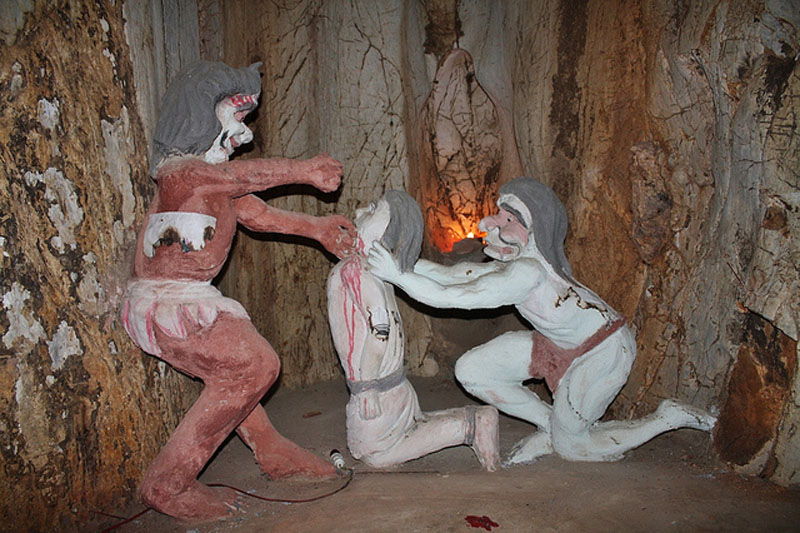
Saint Arahat and legendary Bodhisattvas are those with great morality and superpowers, who mostly use their power to save sentient beings from miseries. In this sculpture set, Saint Mungkalaram is teaching a lesson to his past life mother, interpreting the right and wrong of her past deeds. As long as the lady realizes her sins, feels guilty about them, and starts to think in a more ethical way, she will step by step get away from hell and transfer to a better life.
If you ask a Buddhist when hell ends, he shall reply: “When people live with ethics”.
3. Metal
If you are enjoying your time and want to seem more, do not forget to drop by Mt. Metal. You can see Mt. Metal from the telescope on Mt. Water; Mt. Metal is like a huge bell leaning on Quan Am Pagoda. There, Quan Am Cavern is a must-visit spot. With the gateway facing the Southeast, hidden away from the cliffs, the cavern is particularly hard to find. It was not until 1956 that people discovered this amazing gem. The gateway is small, steep cliffs on both sides; as you get deeper inside, the cavern gets larger. It resembles the shape of the Cam Lo bottle that the Bodhisattva holds in her hand; the cave is 64 meters long, roughly 7 meters high at is tallest part, and 7 meters wide.
Quan Am cave is relatively closed off compared to other caves in the Marble Mountains, with huge rosin fairy figures. Most impressive is a natural marble sculpture of the Bodhisattva in human size, which is believed to be a magical result of the circuit waters’ abrasive process over the past centuries. And guess what? At the center of the cavern’s roof, there is a stalactite that drops to 0.3 meter above the floor, on which when you knock, you will hear the sound reassembling a bell. From the center, walking 2 meters further into the cave, and you will find yourself in front of a beautiful pure water pond. The pond originated from one water circuit from Co Co River, crossing many rock layers, making its water flawlessly clear.
4 & 5. Mt. Plant & Mt. Fire
Contrary to the name, there are not many plants on Mt. Plant, and surely no fire on Mt. Fire. Mt. Plant was said to be, long ago, a beautiful mountain with majestic cliffs. After years of being heavily exploited, today the mountain looks like an old city wall that has long been abandoned.
Mt. Fire is a combination of two mountains (Positive Fire and Negative Fire) connected by a natural rock road. Mt. Positive Fire used to witness a jam-packed harbor on its side back to the time when people were trading between Hoi An and Da Nang on boats. On the river bank, today you can still find broken relics of the old Ong Chai Temple (Ong Chai means fisherman). If you visit this mountain, you should drop by two ancient pagodas: Linh Son Pagoda (with Huyen Vi Cave) and Pho Da Son Pagoda (with Pho Da Son cave). The slopes of the southwest side of the mountain are steep and craggy, pagodas and caves are therefore quiet compared to those on Mt. Water. Sporadic relics of Cham temples still exist in key parts of the mountain, reminding visitors how limited our creations are compared to that of Mother Nature.
Read more: Guide to Visit the Marble Mountains Without a Package Tour
Reviews Marble Mountain on Tripadvisor
Great day out in the mountains. Suggest to take the lift up and walk your way down. Time spent 1-2hrs.
GIT (Melbourne, Australia)
This place really resonated with me it was so tranquil and peaceful, we were so lucky it was quiet and the entry was 2 for 1 and further discounted to go in and up the lift (elevator). Don’t skip it, just go and pick the middle of the day it’ll be hot but quiet and more tranquil.
Troy Hill (Scarborough, UK)
Beautiful and spectacular.
Physically very challenging, so do not attempt if you are not fit, not prepared to climb. The higher you go, the more surprises you will get.
Bring along plenty of water. There are also refreshments kiosks along the way.
KopisiBrand (Singapore)
Getting to Marble Mountain
Marrble Mountain is about 11 kilometers from Da Nang’s city center, close to renowned cultural heritages such as Hoi An and My Son Sanctuary, making it an excellent add-on for your trip.
There are many ways to reach the Marble Mountains from Da Nang city center. You can join a tour, take a taxi or a private car charter. It takes about 15 minutes to get there.
If you’re from Hoi An, drive 20 kilometers north of Hoi An, and you’ll come across a large sign that reads “Marble Mountain.”
The most convenient way is to book a tour as it offers a hassle-free and immersive experience. A tour usually includes pick-up services, entrance tickets, and a guide.

Owing to the magical hand of Nature Mother, Marble Mountains has its mystery of the way to create itself as people see and its hidden beauty behind lifeless stones and caves. Just be there and experience in your own way.
FEATURED TOURS AND EXPERIENCES



